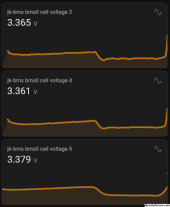Thanks for accepting me as a member! My first thread:
I have a bank with 16 CALB 200Ah LFP. Some running away when charging, some running away when discharging.
If I first do top balance and second do bottom balance, will the cells be like new again? Or will all be balanced to 2,5V but still some run away when charging? Is it the latest balance that counts if a cell do not have 100% capacity?
Suppose this is a chemistry issue?
I have a bank with 16 CALB 200Ah LFP. Some running away when charging, some running away when discharging.
If I first do top balance and second do bottom balance, will the cells be like new again? Or will all be balanced to 2,5V but still some run away when charging? Is it the latest balance that counts if a cell do not have 100% capacity?
Suppose this is a chemistry issue?



